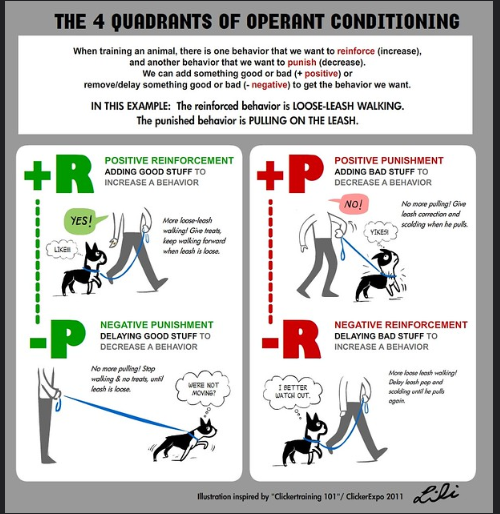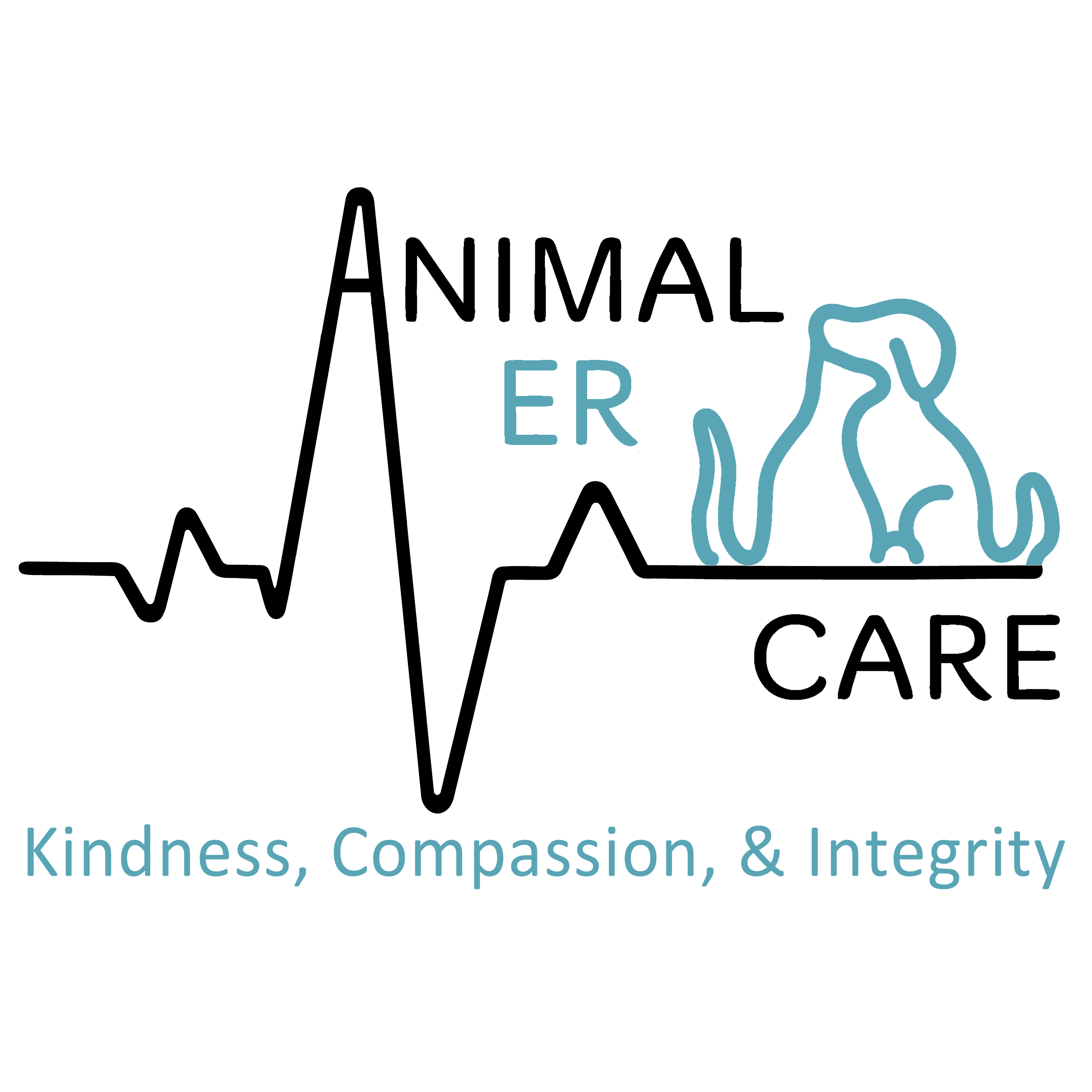Top Training Misconceptions Explained
By: Fernando Diaz (CPD-KA) and Miguel Gonzalez (CPDT-KA)
January is Train Your Dog Month, so we’ve asked our Behavior Programs Managers, Miguel Gonzalez and Fernando Diaz (both Certified Professional Dog Trainers, Knowledge Assessed), to share their responses to common dog training misconceptions below!
Misconception #1 – Positive punishment is the best way to train! (Rubbing a dog’s noise in his accidents helps to house train, dog shaming helps pups learn, spanking helps teach my dog what is “bad”):
This opens up a larger discussion about the four quadrants of operant conditioning for behavior (photo courtesy of ClickerExpo). Rubbing a dog’s nose in its feces is referred to as positive punishment (quadrant two), or the addition of punishment to decrease the occurrence of a behavior (pooping in the house). Many people think this is called “negative reinforcement,” but negative reinforcement (quadrant four) refers to removing something to reinforce a desired behavior, such as pushing on a dog’s bottom to make him sit, then releasing the pressure once the dog is sitting and doing the desired behavior.
Using these techniques can teach fear and often result in aggression. Dog’s don’t understand why their person is suddenly doing these undesirable and scary things. This will lead them to see their owners as unpredictable, and they will fear someone randomly doing “bad” things to them. Instead, by providing direction and positive reinforcement we can teach our dogs what to do. Rather than “rubbing their nose in it,” we can provide a consistent routine where they understand there will be opportunities to go outside, and then we can heavily reinforce them for eliminating appropriately with rewards. Spanking or hitting a dog teaches fear and does not tell a dog what they need to do to avoid punishment. If done often enough, dog’s learn helplessness because they don’t know how to avoid being punished.
Misconception #2 – Dogs need an alpha:
This is a myth and debunked in the show “Adam Ruins Everything.” The term came from a scientist who studied wolves, and he has since recanted, saying that wolves don’t have alphas. Instead, they have family structures similar to humans, where parents and other adults lead, and young ones are taught to carry their weight and respect their elders. Not only is the term “alpha” inaccurate when speaking of wolves, but it is important to remember that dogs are not wolves and do not behave like wolves.
Often, when we describe a dog as needing an alpha, what we’re really describing is a dog that has low/no self-control and does not understand what is expected in the relationship. Instead, our dogs need leaders. By providing direction, consistency, and training, we can teach dogs self-control and to understand what is expected of them. When they understand our expectations clearly, we have a better relationship with our dogs.
Misconception #3 – Tug games make dogs aggressive:
Canids (mammals in the dog family) use the tugging behavior to dismantle carcass. In a happy pack, it is a very social behavior. Tug is a good way to interact with your dog, but it’s best to have some very clear boundaries because the game can result in human injury if a dog lacks self-control and there is no structure to the play. For example, there should be no hand contact, and the game should end if the dog starts thrashing his head side to side. The head thrashing is known as “kill shaking,” and we want to discourage this type of interaction with our dogs so that it never escalates.
Misconception #4 – My dog will “grow out of” bad behaviors (My puppy biting me is cute!):
When not taught self-control, behaviors that are cute when a dog weighs 10 pounds can become problematic, and even dangerous, when the dog grows up. Ask yourself if the behavior will still be cute when the dog is 30 pounds or 90 pounds. A little forethought can go a long way in heading off problems in the long term. Start pondering what you want your dog doing in any given situation, and that will be far more productive than focusing on what you don’t want later on in life.
If never given an alternative behavior (like chewing on a toy instead of your hand), there is no way for dogs to understand that what they are doing is inappropriate. And while there is no truth to the adage, “you can’t teach an old dog new tricks,” there is something to be said about the difficulty of breaking habits that have been practiced over and over again. As puppies, dogs minds are sponges meant to take in their surroundings and learn how to survive. If we teach them appropriate behaviors at a young age using positive reinforcement, we are more likely to end up with confident, adult dogs that understand boundaries and expectations.
Misconception #5 – You can’t teach an old dog new tricks (Some dogs are too stubborn or unintelligent to be trained, there’s no way to train a non-food-motivated dog):
We’ve heard this one a lot in our careers as trainers – people saying their dogs are “too old,” “too dumb,” or “ too stubborn” to be trained. While this may be true for an infinitesimal percentage of dogs experiencing cognitive dysfunction, in general it’s not true. Dogs, like people, are always learning. All behavior has a purpose in our pets, and the level of reinforcement of those behaviors determines whether or not the behavior becomes habit.
While some dogs are more motivated to learn and some are more inclined toward specific types of behaviors, the key is to identify a specific dog’s motivation and utilize that to teach. When told a dog is not food-motivated, we usually ask what food has been used. Many times, owners don’t think to try things like hotdog, turkey or chicken slices, peanut butter or even cheese. You should also think about if your dog is motivated by something other than food. Play opportunities, scent games, outdoor time, tennis balls and affection/attention are just a few of the things that can be used to motivate a dog.
Another factor to consider is distraction. Dog’s learn contextually and need repetition in a variety of situations with a variety of distractions before they generalize a behavior. Generalization is when they fully understand that a specific cue is connected to a specific behavior, no matter the situation. For example, practice “sit,” in the park, in your home, on a walk, at the pet store and more. A dog that will sit in the home is unlikely to sit at the dog park unless their tolerance to distraction has been built up.
Misconception #6 – Puppies are untrainable until they are at least 6 months old:
Like we said before, training can be done at any age. Just like there is no such thing as “too old,” there really isn’t such thing as “too young,” though between the ages of 8 weeks and 24 weeks is when your puppy is the most impressionable. This Critical Socialization Period is when our pups make the hard-coded associations with what’s safe and what’s not, and what good and what’s bad. Early training in this period, along with a good plan for socialization, is a really great way to get your pup off to an amazing start.
The length of the training session and complexity of the behavior should also be taken into account. We often make the mistake of working too long with a dog. A naïve (unaccustomed to training) dog will not have a long attention span, regardless of age. Start your training with a young or unaccustomed dog in short sessions with strong rewards and work your way up! Eventually, with practice, your dog can have a longer attention span and will still do the trained behaviors, even in high-stimuli settings.
Misconception #7 – Food rewards are bribery (Once you use treats, your dog will never listen without them):
Food is a bribe if you treat it like a bribe, meaning you provide the food before the desired behavior is completed. A reward is given during or upon the completion of a behavior. Just like most of us are unlikely to show up to our jobs if not paid, dogs require some form of reward to “work” for you. The harder (more complex) the job or the behavior, the greater the payout should be.
However, once a dog understands (generalizes) a behavior, it is actually hurtful to give treats every time the behavior is performed. If a dog does not know when he/she is going to get a treat for a specific behavior, he/she will tend to work harder at the behavior in case this is THE ONE that will earn the reward. This is similar to why people play slot machines. They know at some point there will be a payout, just not when. So, they keep trying.
Misconception #8 – Your dogs know better because they look “guilty” (Dogs misbehave to get back at you for leaving them):
Unfortunately, this thought process can often lead to abuse. Assuming the dog understands whatever it did was “wrong” is fundamentally flawed because it would require the dog has an understanding of right and wrong, which he/she doesn’t possess. To assign a moral compass of “right and wrong” to a creature that lacks human experience and human language is folly at best.
Unfortunately, people often take a “guilty look” as an admission of guilt, and then punish the dog. But, the look of guilt a person is seeing is actually what’s known as a “calming signal.” Dogs use these calming signals as a way to communicate discomfort and uncertainty in a situation. If you look upset or stressed, your dog will likely respond to that. Dogs are built for reading minute behavioral changes. It’s how they communicate with each other. So, when you are upset about a shoe being torn up, your dog is reacting to you being upset, not the fact that the shoe is torn up.
Think about a time when you were younger and an adult really “chewed” you out (pun intended), with no regard for your age or level of understanding. Think about how it made you feel. You were likely scared or ashamed, leading you to cry. You weren’t crying because you felt guilty, you were crying because you were punished without understanding why, and that made you fearful. Now think about what that would look like if every time you came home there was the potential for an interaction like this. It would cause so much anxiety that even if you did nothing “wrong,” you are still terrified, and permanently look “guilty”!
Want to learn more about dog training tips and tricks?
Check out our Pet Care & Animal Behavior resources page to find info on crate training, socialization, housetraining and more!
#HappyTailsHappyHearts











